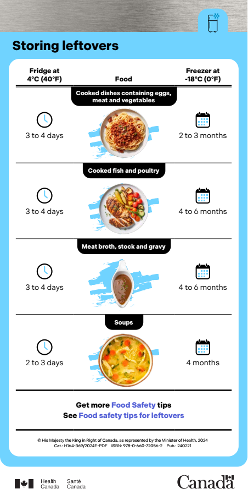Your mission as recipe writers, food journalists, bloggers and chefs: To create recipes that encourage everyone to follow food safety steps at home. Every year about
4 million, or 1 in 8, people in Canada get sick from foodborne illness.

Foodborne illness is also known as food poisoning. Most foodborne illness is preventable with proper food handling. You can play an active role in reducing the risk of foodborne illness by encouraging everyone to follow four food safety steps: clean, separate, cook and chill.
Safe Recipe Style Guide
Health Canada created the
Safe Recipe Style Guide to provide you with easy and flexible ways to add food safety tips to your recipes on your blog, article, cookbook, social media channels, etc. Use the style guide as it suits your recipes and your needs.
By using the style guide for your recipes, you will be helping people improve their food safety practices at home. This may help reduce the risk of people getting sick because of foodborne illness.
The recipes incorporate food safety messages from these 4 key areas:
 clean
clean: wash hands and surfaces often; rinse vegetables and fruit
 separate
separate: don't cross contaminate from raw to cooked food
 cook
cook: cook foods to proper temperatures and check to be sure
 chill
chill: keep cold food cold by refrigerating or freezing promptly
The
Cooking temperatures chart and
Storing leftovers chart, available in hmtl and pdf formats, contain additional information for writing recipes. Consumers can print and keep copies of these charts handy on the fridge, in the kitchen cupboard or drawer for quick reference when cooking. Encourage everyone to share these charts with family and friends so everyone understands the importance of properly cooking and storing food.
.png.aspx?lang=en-CA) Cooking temperature chart
Cooking temperature chart
Here are some tips for using the
Cooking temperatures chart:
- Invest in a digital food thermometer that you will use over and over again and use it to help decrease the risk of foodborne illness. This type of thermometer is used to ‘spot check’ the internal temperature of foods, it does not stay in the food all the time. There are other types of thermometers for that purpose.
- You can buy a digital food thermometer from about $15 – 20 at most grocery, hardware or big box stores or online. Follow manufacturers’ instructions for use and cleaning.
- You can use a digital food thermometer to ‘spot check’ the internal temperature of all types of foods, from thin foods like chicken breasts and hamburgers to whole roasts.
- For thin food like burgers, insert the thermometer through the side of the patty. Check each piece of meat since they may vary in size.
- For larger pieces, like a loin roast, when you think it’s ready, insert the thermometer through the thickest part of the roast, all the way to the middle, not touching any bone. If it’s not ready yet, remove the thermometer, clean it, then check the roast again later.

Tips for using the
Storing leftovers chart:
- Keep it handy whenever you want to decide where you should store your leftovers, either in the fridge or the freezer.
- For example, if you have a lot of roasted turkey leftovers and you know that you will not eat it in 3 to 4 days, it’s best to put it in the freezer right away and eat it within 4 to 6 months.
- Use the Storing leftovers chart to decrease food waste and save money by using up the ‘odds and ends’ of fresh vegetables in your fridge to make soup.
- Making the soup now with the ingredients you have available saves money, decreases food waste and gives you a quick and easy meal for another day. Did you know that you can freeze soup for up to 4 months?
Tech savvy?
For those who love their smart phones and tablets, save the
Cooking temperatures and
Storing leftovers charts as shortcuts on your home screen. Simply search your browser for “how to add a website to my home screen” for your specific device.
We all have a role to play in reducing foodborne illness in Canada. Remember, food safety is in your hands.
Last Update – August 8, 2024